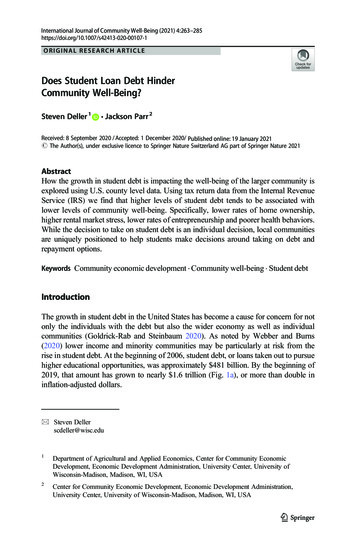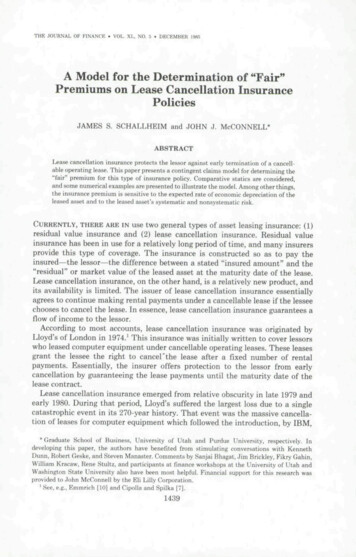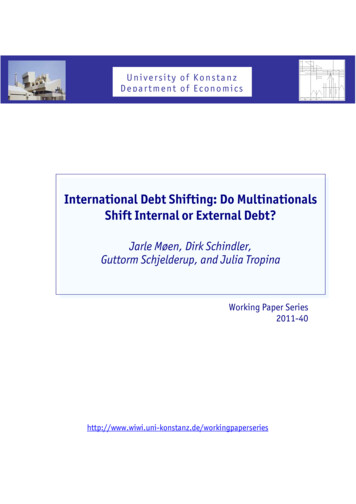
Transcription
STUDENT DEBT CANCELLATION ISPROGRESSIVE: CORRECTING EMPIRICALAND CONCEPTUAL ERRORSISSUE BRIEF BY CHARLIE EATON, ADAM GOLDSTEIN, LAURA HAMILTON, ANDFREDERICK WHERRY JUNE 2021EXECUTIVE SUMMARYIn recent years, student debt cancellation has come to the fore of the national policyagenda, with several proposals currently on the table—including Senator ElizabethWarren (D-MA) and Senate Majority Leader Chuck Schumer’s (D-NY) plan to cancel up to 50,000 of federal student loans per borrower.1Opponents of these proposals have created what we refer to as the “myth of studentloan cancellation regressivity”: the idea that student debt cancellation is regressivebecause it involves a public transfer to a relatively well-off group—those with somecollege education.In this issue brief, we offer three key takeaways for policymakers.1. Contrary to common misperceptions, careful analysis of household wealth datashows that student debt cancellation—at all proposed levels—is progressive; itwould provide more benefits to those with fewer economic resources and couldplay a critical role in addressing the racial wealth gap and building the Blackmiddle class. The reason for this progressivity is simple: People from wealthybackgrounds (and their parents) rarely use student loans to pay for college.2. More substantial student debt cancellation plans, like the Warren-Schumer plan, arein fact more progressive.3. Income eligibility cutoffs and income-driven repayment are inefficient andcounterproductive ways to achieve progressivity.The regressive cancellation myth rests on a series of misleading methodologicalfoundations: including private student loans in calculations of cancellation,conditioning analyses on borrowers only, focusing primarily on debtors’ income ratherthan wealth, basing calculations on the value of debt to the government rather than thevalue to borrowers, and ignoring the racial distribution of debt.1For a draft of the resolution, see: r%20Warren%20resolution.pdf.CR E AT I V E C O M M O N S C O PYR I G H T 2 02 1 R O OSEV ELTI N STI TU TE.OR G1
In this brief, we correct these errors by: Distinguishing federal loans from private debt to reflect existing proposals fordebt cancellation by executive action; Including the full population in our analyses, not just borrowers; Modeling redistribution by wealth, not income; Valuing student debt by what it costs borrowers, not lenders; and Disaggregating the distribution of debt by race.After making these corrections, the progressivity of debt cancellation becomesapparent. For example, in the case of the Warren-Schumer proposal for cancelling 50,000 in debt: The largest share of debt cancellation dollars goes to people with the least wealth,which addresses (but does not close) the racial wealth gap. The average person inthe 20th to 40th percentiles for household assets would receive more than fourtimes as much debt cancellation as the average person in the top 10 percent, andtwice as much debt cancellation as people in the 80th to 90th percentiles (seeFigure 3). Debt cancellation addresses racial disparities in debt burdens by benefitingthose who carry the biggest loan balances. At every point on the income and assetdistributions, Black households would gain equally or more from cancellationrelative to white households. Upwardly mobile Black and Latinx people in the50th to 90th income percentiles would receive the largest average cancellation.This reflects the fact that Black and Latinx students typically have to borrow morefor college expenses than white students of comparable income due to the racialwealth gap in family resources (see Figures 1 and 5). A key metric for financial well-being is the debt-to-income ratio. Debt cancellationleads to the highest reductions in the debt-to-income ratio for people with thelowest incomes. As household income increases, the reduction in the debt-toincome ratio decreases (see Figure 4). Estimated debt cancellation from the Warren-Schumer plan is only 562 perperson (including non-borrowers) in the top 10 percent of households for networth. Estimated cancellation is 17,366 for Black persons and 12,617 for whitepersons in the bottom 10 percent for net worth (see Figure 7).CR E AT I V E C O M M O N S C O PYR I G H T 2 02 1 R O OSEV ELTI N STI TU TE.OR G2
If one analyzes student debt by income instead of wealth, neglects to disaggregateby race, neglects to exclude private debt, and values debt cancellation without adebt-to-income ratio (Catherine and Yannelis 2020), it will misleadingly appearthat people in the 60th to 90th income percentiles receive twice as much benefitfrom cancellation as people in the 30th to 40th percentiles (see Figure 1).In short, the debt cancellation proposal is progressive. It addresses long-standing racialinequities and leads to sharp improvements in household financial well-being.INTRODUCTIONIn the last decades of the 20th century, the US government shifted the financial burdenfor postsecondary education to students and families by prioritizing student loans asthe primary funding mechanism for higher education. Now, we are tasked with cleaningup the mess of that choice, which has financially devastated recent generations ofAmericans—especially those with limited-to-moderate economic resources.Young people from economically less advantaged households have been the mostdirectly impacted by skyrocketing student debt, although the ripple effects extend outto their families and communities. Among students from households with less than 30,000 in income who began college in 2012, 61 percent left school with Title IV federalstudent loan debt.2 By contrast, only 30 percent of students from households with over 200,000 in income left school with such debts. Seventy-four percent of Black studentsleave school with Title IV federal student loan debt compared to 55 percent of whitestudents—reflecting racial differences in income and wealth.Under this new regime of borrowing, people from less advantaged backgrounds struggleto build household wealth (Saez and Zucman 2016: 523, 555). Analyses of FederalReserve data indicate that in 1989, baby boomers (defined as Americans born between1946 and 1964) held seven times the amount of US total net worth as millennials(born between 1981 and 1996) held at the same age in 2019 (Hoffower 2019). Thosegenerational disparities in wealth creation are almost entirely driven by student debt.Without student debt, the median net wealth-to-income ratio for the leading edge ofthe millennial generation looks strikingly similar to that of previous cohorts (Chen andMunnell 2021).Student debt cancellation is not just a generational issue; it is also about racial equity(Charron-Chénier et al. 2020; Zewde and Hamilton 2021). Student debt has played a2This does not include parent borrowing. Data are from the US Department of Education, National Center for EducationStatistics, and 2012/17 Beginning Postsecondary Students Longitudinal Study (Bryan et al. 2019).CR E AT I V E C O M M O N S C O PYR I G H T 2 02 1 R O OSEV ELTI N STI TU TE.OR G3
central role in maintaining and exacerbating a persistent Black-white wealth gap in theUS. Black families, who are more likely to have limited economic resources, rely moreheavily on student debt than other borrowers, at both undergraduate and graduatelevels of education (Addo, Houle, and Simon 2016; Houle and Addo 2018; Pyne andGrodsky 2020). Twelve years after college entry, the typical Black borrower with a fouryear degree owes 114 percent of what they originally borrowed, and the typical Latinxborrower owes 79 percent of what they originally borrowed. In contrast, the averagewhite student with a bachelor’s degree only owes 49 percent of the original amount(Miller 2017).Policymakers have proposed solutions to respond to these social problems. The Bidenadministration initially proposed a plan that cancels up to 10,000 of federally backedstudent loan debt for each American. The Warren-Schumer proposal would task theDepartment of Education with cancelling up to 50,000 in federal loans per borrower.A growing chorus of Democratic lawmakers have urged the Biden administrationto implement the Warren-Schumer proposal via executive action. As advocates andpolicymakers debate the path forward, however, one issue that has emerged as arecurrent flashpoint is the policy’s supposed regressivity.Critics argue that blanket debt cancellation is a regressive social policy because itinvolves a public transfer to a comparatively well-off group—those with at least somecollege education. They also point to the fact that mean student loan balances tend tobe greatest among professionals in the top half of the household income distributionas evidence that blanket cancellation of student debt would disproportionately benefitthe economically advantaged (Catherine and Yannelis 2020; also see Akers 2020; Baum2020; Baum and Looney 2020; Looney 2019). Believing that student debt cancellationrepresents an inefficient mechanism to ease burdens for struggling and lower-incomeborrowers, critics thus propose either abandoning student debt cancellation altogetheror attempting to narrow transfers to specific groups—for instance, through incomecaps for loan cancellation or income-driven repayment plans.In this paper, we tackle what we refer to as the “myth of student loan cancellationregressivity.” This myth arises as a result of several straightforward empirical andconceptual errors that have plagued critiques of student debt cancellation. These errorsinclude: Including private loans, when major proposals only cancel federal student loans; Conditioning analyses on borrowers only, rather than the entire population; Focusing on the distribution of debt by income rather than wealth, even thoughdebt cancellation is a wealth transfer;CR E AT I V E C O M M O N S C O PYR I G H T 2 02 1 R O OSEV ELTI N STI TU TE.OR G4
Highlighting the value of debt to the government, rather than to the borrower;and Ignoring the racial distribution of debt.Together, these errors obscure the reality that economically less advantaged studentsend up with more debt and lower net worth than students from wealthy families whocan afford debt-free higher education. Once we correct these errors, current studentdebt cancellation proposals are shown to be highly progressive, contrary to prioranalyses.Drawing on data from the 2019 Survey of Consumer Finances, we clarify theprogressivity of student debt cancellation by simulating balance sheet transfersto people across the wealth distribution under several alternative student debtcancellation policy variants. The results highlight that blanket cancellation proposalswould disproportionately direct relief to people in the lower quantiles of the wealthdistribution. We further find that larger federal loan cancellation limits result in a moreprogressive wealth transfer.Our analyses consider not just class but race—a glaring omission in some argumentsagainst student debt cancellation. One of the most important and well-documentedbenefits of student debt cancellation is, in fact, the potential to increase Black net worth(Charron-Chénier et al. 2020; Perry and Romer 2021; Steinbaum 2019a; Weller, Maxwell,and Solomon 2019; Zewde and Hamilton 2021). We examine distributional progressivityby racial group and emphasize the importance of student debt cancellation, withoutincome caps or stipulations, for buttressing and building the Black middle class.ERADICATING THE REGRESSIVE DEBTCANCELLATION MYTHThe supposed regressivity of student debt cancellation is perhaps most clearlydemonstrated in recent empirical analyses by Catherine and Yannelis (2020) of the 2019Survey of Consumer Finances (or SCF). Their National Bureau of Economic Researchworking paper, “The Distributional Effects of Student Loan Forgiveness,” has been widelypublicized as empirical “proof” of the regressivity of student debt cancellation, as isevidenced by coverage in the Washington Post, Los Angeles Times, CNBC, and other outlets.In what follows, we first replicate the Catherine and Yannelis (2020) findings, thenaddress each of the misleading empirical and conceptual errors by which they validatethe regressive debt cancellation myth. Note that we rely on the same data as CatherineCR E AT I V E C O M M O N S C O PYR I G H T 2 02 1 R O OSEV ELTI N STI TU TE.OR G5
and Yannelis, as the SCF is widely considered a reliable source for understandinghousehold income, wealth, and debt (see Bricker et al. 2016).3Although our primary focus is on Catherine and Yannelis (2020), they are far fromalone in propagating the myth of regressive student debt cancellation. Many of thesame errors in their analyses can be found in other similar critiques. For example,Baum’s (2020) piece in the “Fallacy of Forgiveness” forum is titled “Mass Debt Forgivenessis Not a Progressive Idea.” Looney (2019) finds the “Warren proposal to be regressive,expensive, and full of uncertainties.” Akers (2021) argues that, rather than the “hugelyregressive idea” of student debt cancellation, policymakers would be better served bysimply relying on income-driven repayment plans. By systematically deconstructingthe Catherine and Yannelis (2020) findings, therefore, we also address a wide range ofregressivity claims.Step by step, we identify how the Catherine and Yannelis analysis falls victim to eachfalse claim of the regressive student debt cancellation myth and indicate how analystsand policymakers should be assessing student debt cancellation proposals. In applyingempirical and conceptual correctives, we provide a much more accurate and progressivepicture of student debt cancellation.DISTINGUISH FEDERAL LOANS FROM PRIVATE DEBTFigure 1 is a replication of Figure 1, Panel A in Catherine and Yannelis’ (2020) paper.4The figure displays the mean student debt per person in households of respondentsbetween age 22 and 60 with student debt.5345SCF data are, however, limited by the fact that the households surveyed are increasingly less representative of thecircumstances of young adults in the US. Burdened by debt, many cannot form independent households, as required bythe SCF sampling frame (see Morgan and Steinbaum 2018).Catherine and Yannelis declined to share their code when requested. Our replications are thus as exact as possible,without utilizing the same code. The code we wrote and data for all analyses and replications in this paper are availableat ellation.We render all figures in this issue brief using the color palette, other style elements, and categorical data visualizationtechniques employed by W. E. B. Du Bois in 1900 to analyze the impacts of slavery, emancipation, and Jim Crow on Blacksocial and economic life (Battle-Baptiste and Rusert 2018). For more information on Du Boisian data visualization, ian-resources/.CR E AT I V E C O M M O N S C O PYR I G H T 2 02 1 R O OSEV ELTI N STI TU TE.OR G6
FIGURE 1: MISLEADING ESTIMATES, CASE APrivate loansFederal loansMEAN DEBT PER CAPITA 10K 8K 6K 4K 2K 00-10% 20-30% 40-50% 60-70% 80-90%10-20% 30-40% 50-60% 70-80% 90-100%INCOME DECILESNote: This figure replicates misleading distributional estimates fromPanel A of Figure 2 in Catherine and Yannelis (2020), which includesprivate student loans even though they are excluded from leadingcancellation proposals. Like Catherine and Yannelis, we also excluderespondents under 22 and over 60, and non-parent loans that are withinthe grace period for students who are currently enrolled or recentlyleft school. Data from Survey of Consumer Finances 2019.At first glance, the figure suggests that, on average, higher-income households are morelikely to carry higher student debt balances than households in lower income deciles. Inparticular, those in households between the 60 and 90 percent deciles would seeminglygain the most from student debt cancellation. This image implies that student debtcancellation is highly regressive and barely of any value to those in the bottom 30percent of the household income distribution.The Catherine and Yannelis version of Figure 1 combines both federal and privatestudent loans. This is misleading because only federal student loans are eligiblefor cancellation under current student debt cancellation proposals from the Bidenadministration and from Senators Warren and Schumer. Unlike total student debtbalances, mean federal loan balances are greatest in the middle (60th to 70th percentile)of the household income distribution.Like the Catherine and Yannelis analysis, prior studies have treated total student debtholdings as synonymous with debt that could be cancelled. Because private loans areheld disproportionately by higher-income and higher-asset borrowers (private loansconstitute 23 percent of student debt for those in the top 30 percent of the householdasset distribution, versus 12 percent of student debt for those in the bottom 30 percent),properly accounting for private loans reveals a more progressive picture of leadingproposals for student debt cancellation.CR E AT I V E C O M M O N S C O PYR I G H T 2 02 1 R O OSEV ELTI N STI TU TE.OR G7
Our replication of Figure 1 illustrates the difference made by removing private debtfrom the naïve scenario that includes private loans (e.g., Catherine and Yannelis 2020,Figure 3, panel B), to reflect current student debt cancellation proposals. We simplydifferentiate federal student loans in red and private student loans in yellow within ourstacked bar chart. This correction alone suggests an approximately 20 percent reductionin the magnitude of mean wealth transfer to households in the 70th to 90th percentilesof the income distribution.INCLUDE THE FULL POPULATION, NOT JUST BORROWERSThe redistributive impacts of student debt cancellation should be measured across thefull distribution of households, rather than solely among the beneficiary population.This is a standard vantage point for evaluating redistributive policies. For instance, theEarned Income Tax Credit may give a lesser credit to a worker who earns 14,000 than aworker who earns 19,000 per year, but the credits are all targeted at the lower end of thedistribution, ultimately making it a progressive policy (see Crandall-Hollick, Falk, andBoyle 2021).Focusing on the full distribution of households is particularly relevant in the case ofeducational debt because student loan balances tend to be more bimodal at higherlevels of socioeconomic status. As Figure 2 illustrates, the subset of high-income andhigh-wealth households that carry student debt tend to carry it in large quantities,but the majority of these households have zero student debt. As a result, mean studentdebt collapses in the top income decile for all households but not in the top decile forborrowers.CR E AT I V E C O M M O N S C O PYR I G H T 2 02 1 R O OSEV ELTI N STI TU TE.OR G8
Yet critiques of student debt cancellation frequently rely on borrower-onlycomparisons. For instance, in Table 2, Catherine and Yannelis (2020) estimate thatwhite borrowers held 67 percent of loan debt and Black borrowers held 22 percent ofloan debt that could be canceled—a factoid picked up by the Washington Post editorialboard (2020). This comparison of borrowers obscures the fact that only 17 percent ofwhite adults have any student debt at all, compared to 27 percent of Black adults. Thatis why the same table from Catherine and Yannelis shows that the average student debtper Black adult is 7,407, compared to 4,962 per white adult. Had the Washington Posteditorial board deliberated more carefully, they may have realized that this per-persondisparity is why the 22 percent Black share of student debt balances far exceeds the 13percent Black share of the US adult population.MODEL REDISTRIBUTION BY HOUSEHOLD WEALTHUnlike income transfer policies, student debt cancellation represents a onetimewealth transfer to households’ balance sheets. As such, it is more appropriate to gaugeits distributional impact across the distribution of household wealth, a cumulativemeasure of a household’s net worth and assets (also see Perry and Romer 2021), ratherthan across the annual household income distribution, as is common among thosewho claim student debt cancellation is regressive. Focusing on household incomesignificantly underestimates the socioeconomic impact on low-wealth borrowers,especially those who are Black and Latinx.The transformation from income categories—as displayed in the replication ofCatherine and Yannelis (2020)—to wealth categories is the most profound yet. Figure3 shows the estimated mean gross wealth transfers per capita across the wealthdistribution under the three most popular student debt cancellation policies. Thefigure takes a conservative approach by estimating wealth transfer by household assetquantiles using a measure of total household assets that excludes household debts,including student debts. Our regression models for estimating debt cancellationcontrol for marriage status of household members and apply the debt cancellationmaximum to each household member reported to have student loans. We show laterthat estimating gross wealth transfers by net worth (including negative net worth fromhousehold debt) produces an even more progressive distribution.CR E AT I V E C O M M O N S C O PYR I G H T 2 02 1 R O OSEV ELTI N STI TU TE.OR G9
Student debt cancellation represents a progressive wealth transfer at all proposedlevels of cancellation. In fact, a more substantial plan is the more progressive option.Compared to the 10,000 Biden plan, a 50,000 student debt cancellation approachgrants almost no additional transfer to people in the top asset decile, and just over anadditional 1,000 on average to 80th to 90th decile households. Meanwhile, it wouldgrant over 4,000 to people in the 20th to 40th percentiles; this is a roughly threefoldincrease over the transfer to that group under the Biden plan.Side by side, Figure 1 and Figure 3 are almost mirror opposites. Why might wealthprovide a very different picture than income? Education is a primary path to socialmobility in the United States. However, individuals from families with limited-tomoderate economic resources are more reliant on student debt as a means to achievetheir educational and career goals. Many of these individuals will eventually arrive athigher incomes as a result of their educational attainment.But adults who grew up in less advantaged families typically fail to catch up to the networth of those who started in more advantaged families. Without multigenerationaltransfers of wealth, student debt can block the accumulation of adult wealth—forexample, by making it more difficult to purchase a home or save for retirement. Whenwe look at student debt across household asset quantiles, we capture the accumulationCR E AT I V E C O M M O N S C O PYR I G H T 2 02 1 R O OSEV ELTI N STI TU TE.OR G10
of advantage (or disadvantage) across generations of families—a perspective favored bymany social scientists who study stratification and inequality (see Hamilton and Darity2017; Houle and Addo 2018; Killewald, Pfeffer, and Schachner 2017; Mare 2011; Pfefferand Schoeni 2016).One might expect that low levels of debt in higher household asset quantiles are afunction of people attaining higher household wealth later in life, by which timethey will have paid off student debt. In fact, the distribution of debt cancellationremains progressive if one compares cancellation between household asset quantilesamong people of the same age. For example, people in the 40th to 60th percentilesfor household assets receive four times as much debt cancellation under the WarrenSchumer plan as people in the top 10 percent, after controlling for age.6 People in the20th to 40th percentiles receive more than three times more cancellation than those inthe top 10 percent, after controlling for age. We present full estimates with age controlsin our online replication package.7 Disparities in wealth between baby boomers in the1980s and millennials today, however, suggest it is highly unlikely that millennials willattain comparable wealth later in life in the absence of debt cancellation. The estimateswithout age controls in Figure 3 therefore provide more informative measures of theprogressivity of debt cancellation by wealth.VALUE DEBT BY WHAT IT COSTS BORROWERSThe economic benefits of student debt cancellation to debtors should not be conflatedwith the accounting value of the loans to the government, in what is known as “netpresent value.” This approach perversely treats a given dollar of debt cancellation asbeing worth less to low-income borrowers because they are statistically less likely to paythe loan back as compared to higher-income borrowers.Catherine and Yannelis (2020) present a number of analyses using present value(see their Figure 1, Panels A and B), which modifies estimates of debt cancellation bytaking into account assumed repayment to the lender across the borrower incomedistribution. These analyses only magnify the regressive pattern that we described inFigure 1, as using present value more than halves the apparent debt reduction reliefthat borrowers in lower income deciles receive through student loan debt cancellation,while hardly impacting estimates for households at or above the 70 percent decile.67We estimate this by controlling for age and an age-squared quadratic term in our regression model for estimating meancancellation by household asset quantile. Code and estimates are available at ssivecancellation.CR E AT I V E C O M M O N S C O PYR I G H T 2 02 1 R O OSEV ELTI N STI TU TE.OR G11
Unpaid debts have substantial costs to low-income borrowers in terms of their ability toaccess consumer credit on favorable terms and to accrue assets over time. These dollarsare not “worth less” in the lives of the low-income individuals who accrue debt. Indeed,trends on saving behavior amid the quasi-experiment of the CARES Act payment freezeprovide new evidence that student debt burdens represent a substantial impedimentto asset building. With federal student loan payments on hold and interest rates set tozero, borrowers were able to enjoy unexpected savings (see Burton and Carpenter 2021).If the goal is to measure the value of debt to a borrower, rather than the lender, a moresensible approach is to use a debt-to-income ratio, as suggested by Steinbaum (2019b). Ashe explains:This measure of progressivity—amount of the benefit, as a share of pre-forgiveness income (or wealth)—is the standard way that distributional analysis is donewhen evaluating policy proposals, e.g., Tax Cuts and Jobs Act of 2017. The idea thatit should be done on the basis of raw dollar amounts by quantile, as you find in theanalyses that claim the plan is regressive, is not the standard approach taken in theevaluation of the distributional impact of policies.This measure more accurately depicts the size of the burden experienced by those inlower-income households, for whom each dollar of debt is actually a more substantialbarrier to economic security, access to consumer credit, and increases in net worth.Following Steinbaum’s approach, Figure 4 depicts the declining debt-to-income ratioacross the distribution of household income under a 50,000 student loan debtcancellation plan. Foreshadowing our final point below, we present this data by racialcategory, highlighting some distributional differences for white, Black, and Latinxhouseholds.CR E AT I V E C O M M O N S C O PYR I G H T 2 02 1 R O OSEV ELTI N STI TU TE.OR G12
For all racial groups, we see that the greatest benefits of student debt cancellationaccumulate to those in the bottom 40 percent of the income distribution. Across theincome distribution, we see that Black individuals receive the largest proportionalreductions in their debt-to-income ratios.DISAGGREGATE THE DISTRIBUTION OF DEBT BY RACEStudent loan debt is not evenly distributed across race. A much greater proportion ofBlack households hold debt than white households, and Black households owe more onaverage than any other racial group (Charron-Chénier et al. 2020).At the time of graduation, Black college graduates owe on average 7,400 more thantheir white peers, but this number quickly grows due to differences in interest accrualand graduate school borrowing; four years after graduation, Black graduates owe almostdouble that of their white counterparts (Scott-Clayton and Li 2016). Six years after thestart of college, nearly a third of Black borrowers and 20 percent of Latinx borrowersdefaulted on their loans—compared to just 13 percent of white borrowers (Miller 2019).Some of these differences can be attributed to racial differences in college completion.But even if we look only at graduates, stark disparities are apparent. Default rates areabout six times higher among Black graduates and two-and-a-half times higher amongLatinx graduates than among white graduates (Nichols and Anthony 2020).Explaining these outcomes requires thinking carefully about the relationship betweenrace and social class in the US. Black, American Indian or Alaska Native, and Latinxstudents are disproportionately more likely to come from low-income families (Taylorand Turk 2019); however, income alone minimizes disparities in economic resourcesavailable to white students relative to their BIPOC peers. Wealth in the US is racialized,such that the median wealth of white households is 20 times that of Black householdsand 18 times that of Latinx households—and these gaps have grown over time (Tayloret al. 2011; also see Hamilton and Darity 2017). The wealth of Black and white families,in particular, is not only quantitatively but qu
50,000 in debt: The largest share of debt cancellation dollars goes to people with the least wealth, which addresses (but does not close) the racial wealth gap. The average person in the 20th to 40th percentiles for household assets would receive more than four times as much debt cancellation as the average person in the top 10 percent, and










